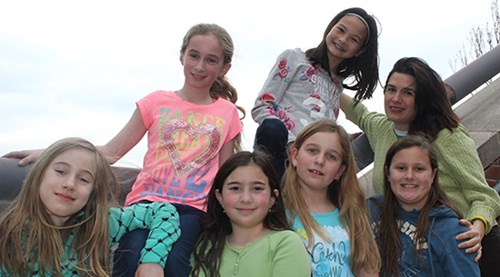Part of our continuing series by teachers, a contribution written by Jennifer Kling, M.S.,
Technology Teacher at Vernfield Elementary School.
TELFORD, PA—It was exciting for me to meet and speak with Bob Sun, creator of the First In Math program, at Lehigh University during the Distinguished Lecture Series we both attended in February. I am not a writer by profession, but our brief meeting—and subsequent email correspondence—inspired me to speak to other teachers about a passion that Sun and I share: drawing more girls into the fields of Science, Technology, Engineering and Math (STEM).

Technology Teacher Jennifer Kling and some of her top female First In Math players—and
hopefully future STEM graduates—at Vernfield ES.
Our nation needs more female programmers. Recently, influential business people, politicians and entertainers have begun to help promote what I call ‘the code movement’ in America. There are several code-writing websites and platforms that have been developed to attract children—and specifically girls—to learn to write code.
But no one can write computer code without basic math skills.
I know that many girls love First in Math. But, by middle school, girls don't appear to feel as good as males about math and computer science in any setting.
As a teacher, I can't tell you how many expensive pieces of software fall apart because of poor coding and yet we are forced to use it. First in Math has always been my yardstick of quality, as it loads quickly, opens beautifully, doesn't crash, works consistently and offers broad, engaging content. The site’s coding is so well done and has been for years. But even a great program can improve its interactions with female students.
Adding more female-oriented themes could open up the world of mathematics for young ladies. Safe and limited opportunities for communication with others, more art with traditionally female colors and even more ‘virtual swag’ such as digital currency, badges of honor, etc., would be welcome. Data shows that females use digital platforms to communicate in much larger numbers than males, so the potential for greater buy-in is certainly there.
I use First In Math to help immerse students into the digital-learning world, and I supplement the program’s virtual rewards with small prizes each time someone in my school earns a group of 1,000 stickers. If my ‘swag box’ is empty, I offer up a 1,000-sticker song and dance that I perform. (Sometimes I think the students empty the box on purpose!)
If you are a math teacher and unsure how you can help your students learn code and experiment with basic programming, I urge you to check out the Code.org site. It is very interesting. Many sites contain videos that are inspirational, and are similar to the TED video series. I also really enjoy the Made With Code videos.
I am in awe of the minds behind First in Math—and was happy to learn that the core programming team includes a woman. And I am full of wonder and excitement at the untapped potential within our female students to be the programmers, website designers and software engineers of tomorrow.
Code.org by Hadi Partovi
Scratch by MIT
Made with Code by Google
Alice by Carnegie Mellon University